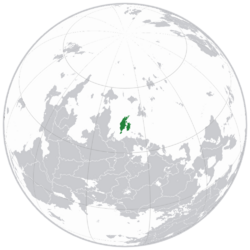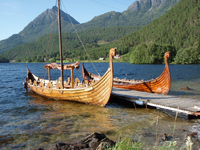Sauthar
Royal Sovereignty of Sauthar | |
|---|---|
 Sauthar in Thuadia | |
| Capital and largest city | Röðväärt |
| Official languages | Sautharian |
| Regional languages | Yurta |
| Ethnic groups (2018) |
|
| Religion (2018) |
|
| Demonym(s) | Sautharian |
| Government | Unitary parliamentary constitutional monarchy |
• Sovereign | Kvieela II (full name: Kvieela Ülja Véþerna Irnatról) |
• Prime Minister | Ilean Higraaþur Ärteatról |
| Legislature | Rékþinog |
| Formation | |
• Settlement | 9th century |
| Area | |
• Total | 228,686 km2 (88,296 sq mi) |
| Population | |
• 2022 estimate | |
• 2018 census | 5,941,706 |
| GDP (PPP) | estimate |
• Total | |
• Per capita | |
| Gini (2018) | low |
| HDI (2018) | very high |
| Currency | Véðar (Ꝟ) (VDR) |
| Time zone | UTC-5 |
| Date format | dd.mm.yyyy |
| Driving side | left |
| Calling code | +754 |
| Internet TLD | .sa |
The Royal Sovereignty of Sauthar (Sautharian: Sáðar Õðäälina/Sáðar Œðæælina [sɑʊ̯ðɑr oɪ̯ðæːlinɑ] ( listen); Yurta: Хамайӹп Сӹтарта [xamaˈɪ̯ʌ̹p sʌ̹taɾˈtʌ̹]) is a country located on the Tünmeer archipelago in the Njorish Sea to the north of Thuadian continent. The country consists of 15 rékan (Sautharian: counties), with the only one that has an autonomous status being the Yurta Autonomous Region - the land of the indigenous people of the archipelago - Yurta.
Sauthar has a total area of 228,686 square kilometres (88,296 square miles) and has a population of about 6,351,648 people as of 2022. It is comprised of five main islands and a number of smaller islands near its main coastline. Sauthar is located in the northern hemisphere, with a humid and cold climate year round. The capital and other areas see precipitations on at least 216 days a year, as the average, with northern Sauthar being known for having heavy snowfall during winter
Kvieela II Ülja Véþerna Irnatról is the current monarch of the Royal Sovereignty. Ilean Higraaþur Ärteatról of the Prosperity Party is the current Prime Minister since 2022, replacing Jöland Ingvar Karltról of the Voice of the Nation party. The state is a unitary constitutional monarchy, where the power is divided between the Rékþinog parliament, the Cabinet and the Supreme Court.
The settlement of the isles took place in approximately the 9th century CE. The predecessor of the current Royal Sovereignty of Sauthar - the Sautharian Empire, however, was established later - in 1105 CE, when Ůlja I has managed to unite all of the major réks of the islands.
Sauthar has two levels of subdivisions: rékan (counties) and kämoonan (municipalities). There are, however, several entities within the Royal Sovereignty that don’t fit in either of the subdivisions. Such entities are: Röðväärt (the capital is both a rék and a kämoon) and the Jurta Sälvrõð Peeläjopp (Sautharian: Yurta Autonomous Region).
The Royal Sovereignty of Sauthar is one of the founding members of the Norterric Assembly and is currently establishing bilateral bonds with the Sekidean Union via the NA.
The country maintains the Norterric welfare model with universal healthcare, high attention to social security and ecology.
Despite christianity being the state religion in the early years of the Sautharian Empire, nordic paganism has again become the most wide-spread religion of the islands in the last two centuries, now accounting for 35% of the population. However, the country has a very large percent of atheistic population - 44%, which has led to a moderate decrease in monarchy's popularity, although many atheists don’t express much contempt for the current constitutional monarchy.
Etymology
History
Settlement
According to the Jórmunbók, first settlers came to the Tünmeer archipelago in 823 CE. They were one of the many tribes, that were attacked during the Sebric feudal wars of the 9th century.
It is said in the Diary of Jórmun that the tribe of Révaõraan was defeated during an attack led by one of the feudals, after what the survivors were sent into exile on their remaining ships.
Arter several harsh weeks of travelling and the deaths of about a fourth of the tribe, Révaõraan have reached the beaches of the Tünmeer archipelago.
During the process of their rapid expansion on the islands of future Sauthar they encountered the native inhabitants of the archipelago - the Yurta.
In their claim of the islands, future Sautharians pushed the Yurta further to the northernmost parts of the land, creating what will be later known as the Yurta Autonomous Region.
The first man to ever map the islands was Ulvar Trán Jellatról by the order of the current monarch of the Nórðrék (Sautharian: the northern realm) - Riel I.
Throughout the 9th century trade with some other nations was established. However, sautharian raids won't begin until the early 900-s.
Period of tribes and Réks
Soon after the arrival on the islands Sautharian society began to split into a number of tribes.
First and biggest tribes split off in the beginning of the 10th century, forming large communes in different parts of the islands. Each tribe established their own Rék (Sautharian: realm), the rulling system of which consisted of the Éþrõðvar (Sautharian: ruler/governor) and the Rékluut - the first analogue of the modern-day parliament, that included the families, that comprised the tribe, and the éþrõðvar as the speaker.
Many of the tribes that lived on the shores of the Tünmeer islands both traded with and raided the near-laying countries, as well as pirated on the trading routes. One of the main trade partners and targets was the reunifying Sivuk Empire.
In their trade the main exports of the Sautharian réks would be sheep, wool, cloth, clothing, ships and fish. Main imports however would be iron and steel, arms, armour, wood.
Establishment of the Sautharian Empire
According to historic studies, the Sautharian Empire (Sáðar Stórmæækjt/Sáðar Stórmäächt) was established in 1105 CE.
The first Stórmääkjtvar/Stórmæækjtvar (Emperor/Empress) of Sauthar was Ůlja Véla Ingvartról. Before the full unification of Sauthar, her father - Ingvar Ůltag Vóltról (Ingvar I) - was a ruler of one of the biggest tribes of Sauthar that got separated from the original Révaõraan tribe.
Ingvar I spent many resources on establishing and supporting trade routes throughout the islands. One of the main areas of his rulling was the enhancement of knowledge exchange and spiritual interaction between the réks.
All of his and his accomplices efforts led to what was known as the Éþrõðvarhitt (Sautharian: the meeting of rulers), where the unification of eight major réks took place. The chosen supreme éþrõðvar - Ingvar I proclaimed the establishment of the Sáðar Stórrék (Sautharian: the Great Rék of Sauthar).
Several years later, after the demise of Ingvar I, the throne was passed on to his daughter - Ůlja I. Throughout her rule Ůlja I payed a visit to the countries across the golf. There she accepted Christianity and brought it back to Sauthar, making it the official religion in 1092 CE.
Two years later Sauthar started making further efforts for the unification of the islands. 13 years later all of the major réks of the Tünmeer archipelago were unified under Sautharian rule. The same year the Sáðar Stórmæækjt was established with the first Stórmæækjtvar being Ůlja I.
Geography
Climate
Biodiversity
Government and politics
Foreign affairs
Military
Administrative divisions
Largest settlements
This article is incomplete because it is pending further input from participants, or it is a work-in-progress by one author. Please comment on this article's talk page to share your input, comments and questions. Note: To contribute to this article, you may need to seek help from the author(s) of this page. |
| Map | Rék | Capital | Population |
|---|---|---|---|
| Röðväärt | Röðväärt | 825,714 | |
| Yurta Autonomous Region | Саппӹр/Sääppor | TBA |
Economy
Demographics
Culture
Literature
Visual arts
Music
Popular culture
Cuisine
Sports
Healthcare
Education
See also



